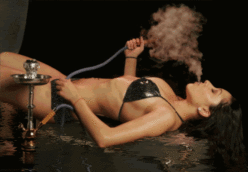People can be very polarized when it comes to the health effects of smoking a hookah. Almost everyone can agree that it isn’t as bad as smoking a cigarette, a pipe, a cigar, and definetely not as bad as smoking a clove (one of my personal favorites). However, smoking a hookah can cause problems over a lifetime. I think the the tradeoff is well worth the smoking, and I dare anyone to tell me that eating ice cream throughout my life doesnt cause some health problems, but I am in no hurry to stop eating ice cream. Anyways, below is an excerpt from Wikipedia about the health effects of smoking a Hookah:
‚ÄúA hookah’s ability to produce pleasant, non-irritating smoke has led many to believe that hookah smoking is less detrimental to one’s health than most other methods of smoking tobacco, such as smoking cigarettes. Unlike cigarettes, where smoke is produced by the ignition and burning of tobacco, hookahs produce a dense, flavorful smoke by heating moistened tobacco. Research has shown that fewer cancer-causing carcinogens are produced because the tobacco is heated, rather than burned. In addition to fewer carcinogens being produced, nicotine production is reduced by the lower temperatures at which the tobacco is heated. Lower nicotine production, when compared to cigarettes, means addiction to tobacco among hookah smokers happens significantly less frequently ‚Äî though this may be due to cultural views and other limiting factors, such as the time required to prepare a hookah for use.
A review published in the medical journal Pediatrics[3] found that the concentration of cancer-causing and addictive substances in water-pipes may be equal to those found in cigarettes, with the heat involved being sufficient to generate carcinogenic nitrosamines, and the smoldering charcoal adding some carcinogenic hydrocarbons as well as heavy metals to the smoke. Similarly, a study in the November 2005 issue of the Journal of Periodontology[4] found that the impact of water pipe smoking is largely the same magnitude as that of cigarette smoking. Ironically, use of the hookah may increase the smoker’s toxic exposure, in that studies have shown that the typical hookah smoker spends more time per episode of smoking than do other smokers, presumably because the smoke is less immediately harsh or irritating. Thomas Eissenberg, a psychology professor at Virginia Commonwealth University co-authored a hookah study which found that a session of hookah smoking which lasts about 45 minutes, delivers 36 times more tar, 15 times more carbon monoxide and 70% more nicotine than a single cigarette. A study in the Journal of Periodontology found that hookah smokers were five times more likely than non-smokers to have signs of gum disease. This is of concern to doctors in America as 86% of colleges and universities are located in close proximity to one or more hookah lounges. A study of Egyptian couples found an association between water-pipe smoking and infertility. However, many objections to the methods used in these studies have been raised. None of the existing studies took into account past tobacco or other drug usage, so it is unclear what ill-effects were directly related to water-pipe smoking, as opposed to past cigarette usage.
Quoting from one of the studies cited below, the quick-lighting charcoal used by many hookah smokers may be “the biggest hazard for hookah users” because it produces greater levels of carbon monoxide and other dangerous substances than all-natural, non-additive charcoal. The quick-lighting charcoal is produced by mixing powdered-charcoal with various chemicals that allow it to be quickly and easily ignited. Ignition of a quicklight coal normally results in the emission of sparks.‚Äù
